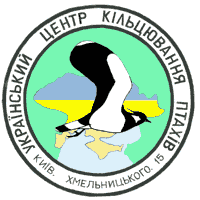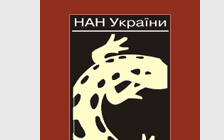|
The Ukrainian Bird Ringing Centre

History of Banding of Birds in Ukraine
Scientific banding of birds began
more than 100 years ago. In 1899, the Denmark teacher Hans Christian
Mortensen from Viborg banded for the first time 165 juvenile starlings.
He tagged birds with aluminium rings with his own minted address
and number. In next year the first data of findings of these birds
were collected at their wintering areas. In 30 years after Mortensen’s
invention, hundreds of thousands of birds were ringed and 9.2
thousand of recoveries were received. This resulted in the first
ever “Atlas of Migrations of Birds” (Schuz E., Weigold H. Atlas
des Vogelzugs. – Berlin. – 1931).
In the former Russian Imperia,
bird banding was utilized for the first time exactly on the territory
of present independent Ukraine. In 1907, landowner F. Falz-Fein
in his own estate “Askania-Nova” and his colleague H. Riberger
tagged two birds with “ROSSITTEN” rings (Germany). In next few
years, the numbers of banded bird grew considerably. During 1907-1923,
in the estate “Askania-Nova” 1908 birds were banded with “ROSSITTEN”
rings. More than five recoveries were received from long distances.
In 1912 the first batch of the
Russian rings marked “ORNITHOL. KOMITET MOSKWA” was made, 13 thousand
total. In the same year, ornithologists began to band birds with
these rings in several areas of Ukraine, namely in present Kyiv,
Poltava, Sumy and Kharkiv regions. On the territory of the estate
“Askania-Nova” they used both “ROSSITTEN” and Russian rings.
In Ukraine after First World War,
usage of the German and Russian rings continued. In addition,
during 1924-1939 the Moscow Biological Station of Young Naturalists
produced rings marked “MOSKWA ÁÞÍ” (the Biostation of Young Naturalists)
in large quantities. These rings were also used on the territory
of Ukraine. In particular, in 1927-1932 1326 birds were banded
with “ROSSITTEN” and 1242 with “MOSKWA ÁÞÍ” rings.
In early 1930s All-Ukrainian Union
of Hunters and Fishers produced rings marked “CHARKOW ÂÓÑÎД in
limited quantity to band ducks. Those rings were the first made
in Ukraine. Unfortunately, banding using these rings proved unsuccessful
due to unskilled registration and accounts. Information of findings
of several birds banded with these rings was received, but initial
banding data were impossible to determine.
Several thousands of birds were
banded with “POLONIA VARSOVIA” rings in five areas of Poland (present
Volyn, Ivano-Frankivsk, Lviv, Rivne and Ternopil regions) in 1932-1939.
Data base contains information of records of 138 birds banded
there.
In Moscow the Bureau of Banding
of the Biological Station of Young Naturalists was established
in 1927 to coordinate bird ringing. Later, in 1934 the Bureau
was reorganized in the Central Bureau of Banding at Committee
of Protected Areas. The scope of bird banding increased each year
in the former Soviet Union. For example in 1954, 100 thousand
birds were ringed and 260 thousand in 1960. In the former USSR
bird ringing was most active in 1970s and 1980s. In particular,
389343 birds were banded in 1983 and 309021 in 1984.
In the middle of XX century in
Ukraine, natural reserves became the main areas of bird banding.
Nearly 350 thousand of birds were banded in Chornomorskyi reserve
during 1947–1974, 16741 in Azovo-Syvaskyi reserve in 1948–1956,
and 21187 in the ”Lebedyni Islands” branch of Krymskyi reserve
in 1949–1967.
The Ringing Bureau of was established
in Academy of Sciences of Ukraine in 1957 to regulate bird banding.
Unfortunately, the Bureau did not manage to fulfill that task.
Even mediating the cooperation of the Bird Ringing Centre in Moscow
and ringers in Ukraine was inadequately carried out. A lot of
banding reports were lost, therefore it was impossible to find
out necessary information when recoveries were received. Thus,
tens of recoveries were lost without initial information. Even
now the total number of birds banded with “MOSKWA” rings on the
territory of Ukraine is unknown due to direct connections of the
Ukrainian ringers with the Bird Ringing Centre in Moscow. The
same is for the information on bird banding for a few years, especially
the 1930-1960s.
In early 1970s active studies of
bird migration were started in the former USSR. It subsequently
caused the appearance of new centers of large scale bird banding.
I. I. Schmalhausen Institute of Zoology at National Academy of
Sciences of Ukraine became one of main center of these studies.
In particular, 229891 birds of 96 species only were banded on
autumn migrations of 1976–2001 at the Ornithological Station “Lebedivka”
at the left bank of Kyiv reservoir of Dnipro River. The Odesa
State University became the second new center of bird ringing,
and its ornithologists in 1974–1984 banded 91009 birds. Bird banding
was also continued in traditional ringing centers, such as Chornomorskyi
reserve and the ”Lebedyni Islands” branch of Krymskyi reserve.
In the middle of 1980s, the Azov-Black Sea Ornithological Station
was established in Melitopol city and its employees devote a lot
of their time to bird banding, catching 5–12 thousand of birds
a year. Thus, Ukrainian ornithologists banded from 40 to 60 thousand
birds in 1976–2001. For instance, there were 46087 banded birds
in 1983, 40618 in 1984, and 54830 were ringed only by scientists
of I. I. Schmalhausen Institute of Zoology and the Azov-Black
Sea Ornithological Station in 1989.
Considerable quantities of birds
were banded in 1990s but average number decreased gradually to
20 thousand, and in 2010–2014 to 10 thousand a year. During 1991–2014,
more than 410 thousand of birds were banded in total, including
280 thousand with “KIEV” rings, approximately 100 thousand with
“MOSKWA”, more 43 thousand with “HELGOLAND”, 1278 with “ATHENS”,
1146 with “BOLOGNA”, and 371 with “HIDDENSEE”.
|
Contacts:
Address:
vul. B. Khmelnytskogo, 15, Kyiv-30, 01030, UKRAINE
E-mail:
polud@izan.kiev.ua (Head of the Centre A. M. Poluda),
ring@izan.kiev.ua (office of the Centre)
Tel:
+380 (44) 235-01-12
|



